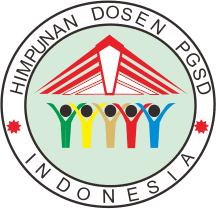Pengaruh gamifikasi terhadap perceived enjoyment pada mata pelajaran ipas sekolah dasar gugus II ahmad yani kecamatan laweyan
Abstract
Keywords
References
[1] M. Y. Harahap, “Proses Pembelajaran Melalui Interaksi Edukatif Dalam Pendidikan Islam,” J. Ilm. Al-Hadi, vol. 7, no. 2, p. 31, 2022, doi: 10.54248/alhadi.v7i2.4245.
[2] O. Asmaul Husnah, A. Fitriani, F. Patricya, and T. Putri Handayani, “https://bajangjournal.com/index.php/JPDSH Analisis Materi Ips Dalam Pembelajaran Ipas Kurikulum Merdeka Di Sekolah Dasar,” JPDSH J. Pendidik. Dasar Dan Sos. Hum., vol. 3, no. 1, pp. 57–64, 2023, [Online]. Available: https://bajangjournal.com/index.php/JPDSH
[3] N. Wayan, P. Andari, I. W. Lasmawan, and I. W. Kertih, “Model Pembelajaran Role Playing Meningkatkan Hasil Belajar IPAS Siswa Kelas V Sekolah Dasar,” vol. 8, no. 4, pp. 644–651, 2024.
[4] S. M. Sari, S. S. Sukarno, and M. M. Matsuri, “Problematika pelaksanaan pembelajaran IPAS kurikulum merdeka materi masyarakat yang beradab kelas IV sekolah dasar,” Didakt. Dwija Indria, vol. 11, no. 5, p. 41, 2023, doi: 10.20961/ddi.v11i5.77703.
[5] M. A. S. Oktarini and I. M. Wardana, “Pengaruh Perceived Ease Of Use Dan Perceived enjoyment Terhadap Customer Satisfaction Dan Repurchase Intention,” INOBIS J. Inov. Bisnis dan Manaj. Indones., vol. 1, no. 2, pp. 227–237, 2018, doi: 10.31842/jurnal-inobis.v1i2.32.
[6] S. Vindy Salsabila, J. Poerwanti, and T. Budiarto, “Analisis kedisiplinan dan motivasi belajar peserta didik dalam proses belajar mengajar di sekolah dasar,” Didakt. Dwija Indria, no. 449, pp. 245–250, 2024.
[7] R. M. Ryan and E. L. Deci, “Intrinsic and Extrinsic Motivations: Classic Definitions and New Directions,” Contemp. Educ. Psychol., vol. 25, no. 1, pp. 54–67, 2000, doi: 10.1006/ceps.1999.1020.
[8] S. Susanti, F. Aminah, I. M. Assa’idah, M. W. Aulia, and T. Angelika, “Dampak Negatif Metode Pengajaran Monoton Terhadap Motivasi Belajar Siswa,” Pedagog. J. Pendidik. dan Ris., vol. 2, no. 2, pp. 86–93, 2024, [Online]. Available: https://journal.ummat.ac.id/index.php/fkip/article/view/10044/pdf
[9] A. Z. Purba, F. Hilmy Nasution, K. M. Parapat, M. Jannah, and N. Ulkhaira, “Gamifikasi Dalam Pendidikan: Meningkatkan Motivasi dan Keterlibatan Siswa,” Maximal J. J. Ilm. Bid. Sos. Ekon. Budaya dan Pendidik., vol. 1, no. 5, pp. 1–7, 2024, [Online]. Available: https://malaqbipublisher.com/index.php/MAKSI
[10] T. A. Grzeszczyk, “AI in Business,” Artif. Intell. Proj. Manag., pp. 4–21, 2024, doi: 10.4324/9781003341611-2.
[11] K. Redy Winatha and K. A. Ariningsih, “Persepsi mahasiswa terhadap penerapan gamifikasi dalam pembelajaran,” J. Pendidik. Teknol. dan Kejuru., vol. 17, no. 2, pp. 265–274, 2020, [Online]. Available: https://ejournal.undiksha.ac.id/index.php/JPTK/article/view/26010
[12] A. Rostiani, A. Sujana, and A. K. Jayadinata, “Pengaruh Pembelajaran Berbasis Gamifikasi Terhadap Penguasaan Konsep dan Motivasi Siswa pada Materi Siklus Air,” AR-RIAYAH J. Pendidik. Dasar, vol. 7, no. 2, p. 85, 2023, doi: 10.29240/jpd.v7i2.8116.
[13] D. Ariani, “Gamifikasi untuk Pembelajaran,” J. Pembelajaran Inov., vol. 3, no. 2, pp. 144–149, 2020, doi: 10.21009/jpi.032.09.
[14] Sugiyono, “Metode Penelitian.pdf,” Ghalia Indonesia. Alfabeta, Bandung, pp. 110–111, 2022.
[15] L. Nilawati, U. Katolik, and I. Atma, “Peran Teori Motivasi Terhadap Kreativitas Individu Karyawan : Hasil Sebuah Review,” vol. XVIII, 2024.
[16] W. N. A’ini, R. Riyadi, and T. Budiharto, “Pengaruh pemberian reward dan ice breaking terhadap minat belajar matematika,” Didakt. Dwija Indria, vol. 11, no. 6, p. 72, 2023, doi: 10.20961/ddi.v11i6.76748.
[17] N. A. Fauzi, L. L. Jannah, and A. Azis, “Penerapan Gamifikasi Powtoon dan Quizizz dalam Meningkatkan Motivasi Belajar Akidah Akhlak Siswa SMA Negeri 6 Palangka Raya,” vol. 03, no. 02, 2024.
[18] S. Deterding, “Gamification : Toward a definition Gamification : Toward a Definition,” no. July, pp. 11–15, 2017.
[19] DINDA SUKMANINGRUM.,ST.,MM and Dodi Setiawan Riatmaja, “Pengaruh Gamifikasi Pekerjaan dan Kepuasan Kerja terhadap Enjoyment Karyawan Perusahaan Startup di Yogyakarta,” J. Apl. Bisnis, vol. 20, no. 2, pp. 473–482, 2023, doi: 10.20885/jabis.vol20.iss2.art4.
Refbacks
- There are currently no refbacks.



